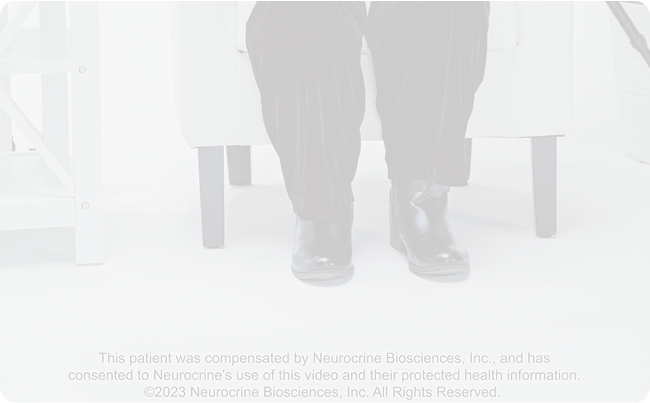

~4 mins
•Jan 2025
Digesting the DSM Lingo
In this quiz, clips from an Abnormal Involuntary Movement Scale (AIMS) exam will depict a real patient’s Tardive dyskinesia (TD) symptoms. As the video plays, there will be an AIMS score sheet to fill out to practice scoring the severity of symptoms in each body region.
Upon completion, expert ratings and commentary will be available to view.
As the video plays, complete the first 7 questions on the AIMS score sheet. After submission, the quiz will automatically generate a value for the AIMS TD score, which is the sum of items 1 through 7.
After completion of the score sheet, along with ratings and commentary from TD experts. Remember that there is no “right” answer, but rather clinicians should strive to be as consistent as possible between patients and across clinical encounters.
The AIMS is a 12-item, clinician-rated scale used to assess symptom severity in patients with TD.1 In this quiz, only items 1 through 7 will be scored, which rate the severity of TD in various body regions on a scale from 0 (none) to 4 (severe). The body regions assessed by items 1 through 7 of the AIMS include: facial and oral movements, extremity movements, and trunk movements, and the remaining items of the exam include global judgments related to severity, incapacitation, and patient awareness of these movements.1
Experts agree that no specific score threshold suggests the need for intervention; instead, clinicians should consider the impact of the TD movements on the individual patient.2 The American Psychiatric Association Practice Guideline recommends treatment for moderate to severe or disabling TD, and states that treatment for mild TD can be considered on the basis of factors like patient preference, associated impairment, or effect on psychosocial functioning.2 Click here for more on the AIMS.


References
Guy W. ECDEU Assessment Manual for Psychopharmacology: Revised. National Institute for Mental Health, Psychopharmacology Research Branch; 1976:534-537.
Hauser RA, Meyer JM, Factor SA, et al. Differentiating tardive dyskinesia: a video-based review of antipsychotic-induced movement disorders in clinical practice. CNS Spectr. 2022;27(2):208-217.
Menzies V, Farrell S. Schizophrenia, tardive dyskinesia, and the Abnormal Involuntary Movement Scale (AIMS). J Am Psychiatr Nurses Assoc. 2002;8:51-56.
American Psychiatric Association. The American Psychiatric Association Practice Guideline for the Treatment of Patients with Schizophrenia. American Psychiatric Association; 2021.
Caroff SN, Citrome L, Meyer J, et al. A modified Delphi consensus study of the screening, diagnosis, and treatment of tardive dyskinesia. J Clin Psychiatry. 2020;81(2):19cs12983.
Based on your answers, your AIMS dyskinesia total score is:
See expert ratings and commentary below:
Facial and Oral Movements
Extremity Movements
Trunk Movements
Clinical Professor of Psychiatry
University of California
San Diego, CA
Muscles of facial expression:
Movements in the upper face were not abnormal, hence the rating of 0.
Lips and perioral area:
Movements were moderate and present throughout the exam, so I rated a 3.
Jaw:
Movements were moderate and present throughout the exam, so I rated a 3. These may actually be of sufficient severity to warrant a 4.
Tongue:
Movements were minimal, even with distracting maneuvers. Hence, I rated a 1, but it is possible they are not pathological.
Upper extremities:
Finger and wrist movements were seen at rest, but no upper arm movements were observed, so I rated a 1.
Lower extremities:
I observed repeated movements of the ankles and legs, and also foot tapping. The ankle and leg movements were of mild severity which I rated as a 2. The foot tapping may be voluntary or due to akathisia and needs more investigation, but this would not influence the score for this item.
Neck, shoulders, and hips:
I observe transient rocking but no truncal, neck, shoulder, or hip movements. The rocking did not appear to be persistent, which raises the suspicion of a voluntary movement. Therefore, I scored this item as a 0.
One limitation of this AIMS exam is that the patient wasn’t willing to remove her shoes.
Associate Professor, Department of Neurology
Oakland University William Beaumont School of Medicine
The video begins with the patient sitting in a chair and looking at the phone. She appears comfortable, but she has bilateral, asynchronous tapping. These could be foot stereotypy or associated with akathisia. If she complained of subjective restlessness, this would favor akathisia. As the camera pans up, we see repetitive high-amplitude, frequent chewing movements and jaw protrusion. With the hands hanging, no resting tremor is seen, arguing against any parkinsonism. As the camera focuses on her upper torso and face, in addition to a chewing movement, there is a repetitive, patterned mouth puckering movement. When the tongue is protruded, tongue enlargement is noted, suggesting overactivity causing hypertrophy, and intraoral tongue movements can be inferred. With sitting, foot tapping is again seen. Her gait is consistent with her advanced age; her normal arm swing and posture again argues against any parkinsonism. When standing in place, she does not rock side-to-side.
Professor of Neurology
University of South Florida
Director, Parkinson’s Disease and Movement Disorders Center
Tampa, FL
Muscles of facial expression:
I did not see any abnormal movements in the upper half of the patient’s face, so I rated item 1 a 0.
Lips and perioral area:
In the lower face, the patient has prominent lip puckering and some puffing movements. When assessing lip movements, one has to rate these separately from the patient’s very prominent jaw movements. Note that passive lip movements due to jaw movements should not be rated in item 2, as these would be included in item 3 (jaw). Overall, I believe her lip movements are moderate and present during most of the exam, hence I rated a 3.
Jaw:
Jaw movements are severe and present through most of the exam, hence I rated a 4.
Tongue:
I debated between a 0 and a 1 for the tongue. She has extremely slight tongue movements, however ultimately, I felt these were trivial and that 0 was the most appropriate rating.
Upper extremities:
She has abnormal movements in her fingers and wrists. These are low amplitude and probably not present most of the time, as we see her hands resting in her lap with no movement at times. As I believe these are low-amplitude movements and present only some of the time, I believe the most accurate rating is a 1.
Lower extremities:
She clearly has abnormal movements about the ankles and slight movements in her legs. Although I debated whether to call her foot movements mild or moderate, I think the most accurate description is mild and present during most of the exam, hence my rating of 2.
Neck, shoulders, and hips:
In the beginning of the video the patient has slight rocking movements that, in my opinion, are sufficient to warrant a rating of 1.
A limitation of practicing AIMS rating using short video clips is that we skip around in the examination of body parts. During an actual examination, one should take an orderly approach.
Note that the ratings should capture both the amplitude and persistence of the abnormal movement. For example, a moderate-amplitude movement that is only present during some of the exam may be a 2, whereas a moderate-amplitude movement that is present during most of the exam may be a 3. Keep in MIND that in this short video, there may not be as much information available about the persistence of the patients’ abnormal movements when compared to full-length exams.
A lot of times, when performing the AIMS exam, I can narrow down the potential rating to 2 possible scores. Then, through careful observation, I can decide which of those 2 possible scores best captures the amplitude and persistence of the abnormal movement. Being consistent from exam to exam and from patient to patient is key.
The AIMS provides a standardized scoring system to evaluate and follow changes in the abnormal movements of tardive dyskinesia. Remember, however, that the AIMS score is only part of the picture; one must also assess the social, emotional, and functional impacts of the abnormal movements to assess their full impact.